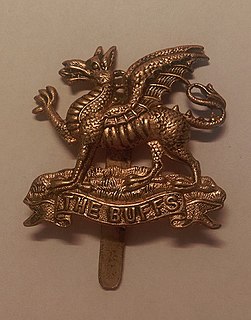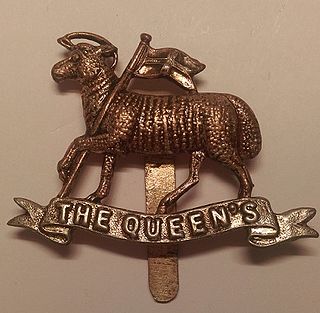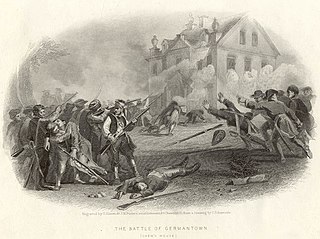
Field Marshal Sir George Howard KB, PC was a British military officer and politician. After commanding the 3rd Regiment of Foot at the Battle of Fontenoy in May 1745 during the War of the Austrian Succession and after commanding that regiment again at the Battle of Falkirk Muir and the Battle of Culloden during the Jacobite Rebellion, he returned to the continent and fought at the Battle of Lauffeld. He went on to command a brigade at the Battle of Warburg during the Seven Years' War. He subsequently became the Governor of Minorca.

The 8th (King's) Regiment of Foot, also referred to in short as the 8th Foot and the King's, was an infantry regiment of the British Army, formed in 1685 and retitled the King's on 1 July 1881.

The Royal Fusiliers was a line infantry regiment of the British Army in continuous existence for 283 years. It was known as the 7th Regiment of Foot until the Childers Reforms of 1881.

The Buffs , formerly the 3rd Regiment of Foot, was a line infantry regiment of the British Army traditionally raised in the English county of Kent and garrisoned at Canterbury. It had a history dating back to 1572 and was one of the oldest regiments in the British Army, being third in order of precedence. The regiment provided distinguished service over a period of almost four hundred years accumulating one hundred and sixteen battle honours. In 1881, under the Childers Reforms, it was known as the Buffs and later, on 3 June 1935, was renamed the Buffs .

The Royal Northumberland Fusiliers was an infantry regiment of the British Army. Raised in 1674 as one of three 'English' units in the Dutch Anglo-Scots Brigade, it accompanied William III to England in the November 1688 Glorious Revolution and became part of the English establishment in 1689.

The Royal Norfolk Regiment was a line infantry regiment of the British Army until 1959. Its predecessor regiment was raised in 1685 as Henry Cornwall's Regiment of Foot. In 1751, it was numbered like most other British Army regiments and named the 9th Regiment of Foot.

The Queen's Royal Regiment was a line infantry regiment of the English and later the British Army from 1661 to 1959. It was the senior English line infantry regiment of the British Army, behind only the Royal Scots in the British Army line infantry order of precedence.
General Sir William Keppel GCB was a British soldier and colonial administrator.

The 42nd Regiment of Foot was a Scottish infantry regiment in the British Army also known as the Black Watch. Originally titled Crawford's Highlanders or the Highland Regiment and numbered 43rd in the line, in 1748, on the disbanding of Oglethorpe's Regiment of Foot, they were renumbered 42nd and in 1751 formally titled the 42nd (Highland) Regiment of Foot. The 42nd Regiment was one of the first three Highland Regiments to fight in North America. In 1881 the regiment was named The Royal Highland Regiment , being officially redesignated The Black Watch in 1931. In 2006 the Black Watch became part of the Royal Regiment of Scotland.

The 31st (Huntingdonshire) Regiment of Foot was an infantry regiment of the British Army, raised in 1702. Under the Childers Reforms it amalgamated with the 70th (Surrey) Regiment of Foot to form the East Surrey Regiment in 1881.
The Battle of Arroyo dos Molinos took place on 28 October 1811 during the Peninsular War. An allied force under General Rowland Hill trapped and defeated a French force under General Jean-Baptiste Girard, forcing the latter's dismissal by the Emperor Napoleon. A whole French infantry division and a brigade of cavalry were destroyed as viable fighting formations.
The following units and commanders fought in the Battle of Paoli during the American Revolutionary War. The Battle of Paoli was part of the Philadelphia campaign of the American Revolutionary War fought on September 21, 1777 in the area surrounding present-day Malvern, Pennsylvania.

General William Gordon, of Fyvie, was a British general and courtier. He was several times returned to Parliament by the interest of the Duke of Marlborough, and precipitated a family quarrel with his nephew, the Duke of Gordon, by commandeering a regiment that the latter was raising.

The Battle of Germantown on 4 October 1777 pitted a 9,000-man British army under General William Howe, 5th Viscount Howe against an 11,000-strong American army commanded by General George Washington. After an initial advance, the American reserve allowed itself to be diverted by 120 English soldiers holding out in the Benjamin Chew House. A heavy morning fog disoriented the American assault columns and led to a friendly fire incident between elements of Major General John Sullivan's right column and Major General Nathanael Greene's left column. At about this time, the American attack lost impetus and both columns retreated. Meanwhile, two wide flanking columns numbering 3,000 American militia had little effect on the outcome. American losses was numbered at 673 soldiers killed and wounded plus 400 captured, while the British suffered 520 casualties.

At the Battle of Brandywine on September 11, 1777 a colonial American army led by General George Washington fought a British-Hessian army commanded by General William Howe, 5th Viscount Howe. Washington drew up his troops in a defensive position behind Brandywine Creek. Howe sent Lieutenant General Wilhelm von Knyphausen's 5,000 troops to demonstrate against the American front at Chadd's Ford. Meanwhile, Lieutenant General Charles Cornwallis took 10,000 troops on a wide flank march that crossed the creek and got in the rear of the American right wing under Major General John Sullivan. The Americans changed front but Howe's attack broke through.
Russell Manners was a British Army officer.
Lieutenant-General Sir Charles Montagu KB was a British Army officer.
General the Honourable John Fitzwilliam was a British Army officer.
Lieutenant-General Thomas Meredyth or Meredith, of Chelsea, Middlesex, was an Irish officer of the British Army and a politician who sat in the Parliament of Ireland from 1703 to 1719 and as a Whig in the British House of Commons from 1709 to 1710..
Lieutenant General Percy Kirke was a British Army officer who became colonel of the 2nd Regiment of Foot.











